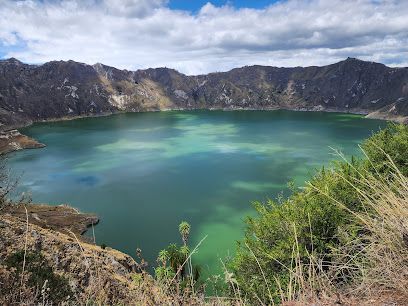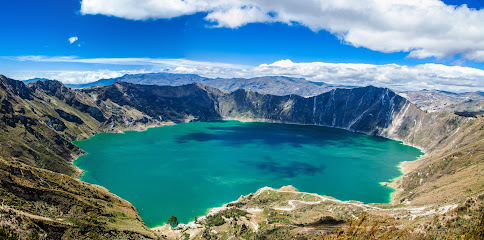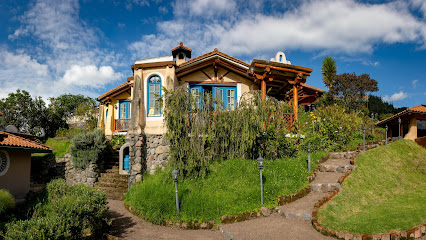
Quilotoa Crater Lake: Ecuador's Gem of the Andes
Discover Quilotoa Crater Lake, a stunning emerald-green lake nestled in an ancient volcanic crater, offering breathtaking hikes and rich cultural experiences in the Ecuadorian Andes.
Quilotoa Crater Lake is a stunning natural wonder located in the Ecuadorian Andes. This emerald-green lake sits in the crater of an ancient volcano, offering breathtaking views and a tranquil atmosphere. The lake is about 3 kilometers wide and is surrounded by rugged cliffs, making it a perfect spot for hiking and photography. Visitors can hike around the rim of the crater for panoramic views that are simply unforgettable. The hike can be challenging, but the scenery is well worth the effort. For those who prefer a more relaxed experience, there are also options to take a mule ride down to the lake's shore. The local indigenous communities add a rich cultural element to your visit. You can explore nearby villages, where you'll find traditional crafts and delicious local cuisine. Quilotoa Crater Lake is not just a feast for the eyes but also a unique cultural experience, making it a must-visit destination in Ecuador.
Local tips in Quilotoa Crater Lake
- Bring warm clothing as temperatures can drop significantly, especially in the evenings.
- Start your hike early in the morning to avoid the midday sun and to catch the best views.
- Consider hiring a local guide to enhance your understanding of the area's geology and culture.
- Stay hydrated and bring snacks, as there are limited facilities around the lake.
- Check out the local markets for unique handmade crafts and souvenirs.
Quilotoa Crater Lake: Ecuador's Gem of the Andes
Quilotoa Crater Lake is a stunning natural wonder located in the Ecuadorian Andes. This emerald-green lake sits in the crater of an ancient volcano, offering breathtaking views and a tranquil atmosphere. The lake is about 3 kilometers wide and is surrounded by rugged cliffs, making it a perfect spot for hiking and photography. Visitors can hike around the rim of the crater for panoramic views that are simply unforgettable. The hike can be challenging, but the scenery is well worth the effort. For those who prefer a more relaxed experience, there are also options to take a mule ride down to the lake's shore. The local indigenous communities add a rich cultural element to your visit. You can explore nearby villages, where you'll find traditional crafts and delicious local cuisine. Quilotoa Crater Lake is not just a feast for the eyes but also a unique cultural experience, making it a must-visit destination in Ecuador.
When is the best time to go to Quilotoa Crater Lake?
Iconic landmarks you can’t miss
Mirador to Laguna Quilotoa
Experience the breathtaking beauty of Laguna Quilotoa from the Mirador, a stunning observation deck nestled in the heart of Ecuador's Andes mountains.

Quilotoa Lake
Experience the stunning turquoise waters and breathtaking views of Quilotoa Lake, a volcanic masterpiece nestled in the Andes of Ecuador.

La Laguna Quilotoa
Explore the breathtaking beauty of Laguna Quilotoa, a mesmerizing crater lake in Ecuador's Andes, perfect for hiking and immersion in nature.

Quilotoa
Experience the stunning beauty of Quilotoa, a volcanic crater lake in Ecuador known for its turquoise waters and rich cultural heritage.

Laguna Quilotoa
Discover the stunning beauty of Laguna Quilotoa, Ecuador's breathtaking crater lake surrounded by lush landscapes and rich indigenous culture.

Viewpoint Quilotoa Lake
Explore the stunning Quilotoa Lake viewpoint, a breathtaking volcanic crater in Ecuador known for its vibrant turquoise waters and scenic hiking trails.

Unmissable attractions to see
Toachi River Canyon
Experience the breathtaking beauty of Toachi River Canyon in Ecuador, where stunning landscapes and adventure blend harmoniously.

Quilotoa
Explore the breathtaking beauty of Quilotoa, a stunning volcanic crater lake in the Andes of Ecuador, known for its vibrant turquoise waters and rich culture.

Mirador Monte Juyende
Experience the breathtaking views at Mirador Monte Juyende, a stunning viewpoint over a crater lake in Ecuador's scenic Quinta Tunguiche region.

Essential places to dine
Mirador to Laguna Quilotoa
Experience unparalleled beauty at Mirador to Laguna Quilotoa with its stunning crater lake views and rich cultural heritage.

Quilotoa Lake
Explore Quilotoa Lake: A breathtaking crater lake in Ecuador known for its vibrant turquoise waters and stunning Andean landscapes.

Hosteria Chukirawa
Discover tranquility and adventure at Hosteria Chukirawa by Quilotoa Lake, where nature's beauty meets cozy accommodations.

Shalala Lodge
Discover tranquility at Shalala Lodge, where luxury meets nature in Ecuador's breathtaking Quilotoa region.

Runa Wasi Quilotoa
Discover tranquility and adventure at Runa Wasi Quilotoa - your gateway to Ecuador's stunning crater lake and lush landscapes.

Hosteria Alpaka Quilotoa
Discover serenity at Hosteria Alpaka Quilotoa - your gateway to breathtaking landscapes and authentic Ecuadorian hospitality.

Restaurante Sinchy Tupak
Discover exquisite Ecuadorian cuisine with breathtaking views at Restaurante Sinchy Tupak in Chugchilán.

Restaurante Quilotoa
Experience authentic Ecuadorian cuisine with breathtaking views at Restaurante Quilotoa near Laguna de Quilotoa.

Pacha Volkan
Experience authentic Ecuadorian cuisine with breathtaking views at Pacha Volkan in Quilotoa.

The Spoon Quilotoa
Experience authentic Ecuadorian cuisine at The Spoon Quilotoa with breathtaking views of Laguna Quilotoa.

Markets, malls and hidden boutiques
Quilotoa Lake
Discover the breathtaking beauty of Quilotoa Lake, a stunning volcanic caldera in the heart of the Ecuadorian Andes, perfect for adventure seekers and nature lovers.

Toachi River Canyon
Experience the stunning vistas and natural beauty at Toachi River Canyon, a must-visit observation deck in Ecuador's breathtaking landscapes.

La Laguna Quilotoa
Discover the stunning turquoise waters of La Laguna Quilotoa, a must-visit hiking area in the heart of Ecuador's Andes Mountains.

Quilotoa
Explore Quilotoa, Ecuador's breathtaking volcanic crater lake, where stunning landscapes meet rich cultural experiences.

Hosteria Chukirawa
Experience the beauty of Quilotoa at Hosteria Chukirawa, where stunning views meet authentic Ecuadorian hospitality.

Llullu Llama Mountain Lodge
Discover the charm of Llullu Llama Mountain Lodge, your ideal retreat in Isinlivi, Ecuador, for adventure and relaxation amidst stunning Andean landscapes.

Mirador de Cristal Shalalá
Discover breathtaking views and friendly llamas at Mirador de Cristal Shalalá in Malingua Pamba, a scenic haven for tourists in Ecuador.

Runa Wasi Quilotoa
Experience the stunning beauty of Quilotoa at Runa Wasi, where comfort meets adventure in the heart of Ecuador's Andes.

Hosteria Alpaka Quilotoa
Discover serene landscapes and cultural richness at Hosteria Alpaka Quilotoa, your gateway to the breathtaking Quilotoa lake and Andean adventures.

Viewpoint Quilotoa Lake
Experience the breathtaking beauty of Quilotoa Lake, a stunning volcanic crater lake in Ecuador, perfect for adventure and cultural experiences.

Essential bars & hidden hideouts
Mirador to Laguna Quilotoa
Discover the stunning beauty of Laguna Quilotoa at its breathtaking observation deck, where nature meets adventure in Ecuador's Andes.

Quilotoa Lake
Discover Quilotoa Lake, Ecuador's stunning volcanic crater lake, surrounded by majestic mountains and rich indigenous culture.

Toachi River Canyon
Experience stunning vistas and natural beauty at Toachi River Canyon, a must-visit observation deck in Ecuador's breathtaking landscapes.

Quilotoa
Discover the breathtaking Quilotoa Crater Lake, a stunning volcanic gem in Ecuador with turquoise waters, hiking trails, and rich cultural experiences.

Hosteria Chukirawa
Discover tranquility and adventure at Hosteria Chukirawa, where stunning views of Quilotoa lagoon await your visit.

Llullu Llama Mountain Lodge
Experience the tranquility and beauty of the Andes at Llullu Llama Mountain Lodge, your gateway to the Quilotoa Loop and authentic Ecuadorian culture.

Hostal Cloud Forest
Discover tranquility at Hostal Cloud Forest in Chugchilán, a serene base for exploring Ecuador's breathtaking cloud forests and vibrant local culture.

Crater Rooftop Bar
Experience breathtaking views and vibrant flavors at Crater Rooftop Bar in Baños, the ultimate destination for relaxation and culinary delight.

Shalala Lodge
Discover the tranquil beauty of Shalala Lodge, where stunning views of Laguna Quilotoa meet eco-friendly comfort in the heart of the Andes.

Hostal Café Tiana
Discover the charm of Latacunga at Hostal Café Tiana, your comfortable haven for exploring Ecuador's stunning landscapes and rich culture.

Black Sheep Inn
Experience the perfect blend of comfort and adventure at Black Sheep Inn, your eco-friendly retreat in the heart of Chugchilán, Ecuador.

Hostel Sendero De Volcanes
Discover the beauty of Ecuador from Hostel Sendero De Volcanes - the perfect blend of comfort and adventure in Latacunga.

Hostal Taita Cristóbal
Discover the charm of Isinliví at Hostal Taita Cristóbal, where comfort meets adventure in the heart of Ecuador's stunning landscapes.

Runa Wasi Quilotoa
Experience breathtaking beauty at Runa Wasi Quilotoa, a serene hotel beside the stunning Quilotoa crater lake in Ecuador.

Hostal Mama Hilda
Discover the serene retreat of Hostal Mama Hilda in Chugchilán, a haven for travelers exploring the spectacular Andean landscapes of Ecuador.

Local Phrases about Quilotoa Crater Lake
-
- HelloShimi
[shee-mee] - GoodbyeKali
[kah-lee] - YesEe
[ee] - NoMana
[mah-nah] - Please/You're welcomeSílalama
[see-lah-lah-mah] - Thank youYallik
[yah-leek] - Excuse me/SorryPakari
[pah-kah-ree] - How are you?Ima shimi?
[ee-mah shee-mee] - Fine. And you?Alli. Ima?
[ah-lee ee-mah] - Do you speak English?Inglish shamukunata yachashkanki?
[ing-gleesh shah-moo-koo-nah-tah yah-chahsh-kahn-kee] - I don't understandMana rikurishka
[mah-nah ree-koo-ree-shkah]
- HelloShimi
-
- I'd like to see the menu, pleaseMenuka rikushka, s'ilalama
[meh-noo-kah ree-koo-shkah, see-lah-lah-mah] - I don't eat meatChakra mana mikushka
[chah-krah mah-nah mee-koo-shkah] - Cheers!Salud!
[sah-lood] - I would like to pay, pleaseShukushka, s'ilalama
[shoo-koo-shkah, see-lah-lah-mah]
- I'd like to see the menu, pleaseMenuka rikushka, s'ilalama
-
- Help!Yanapan!
[yah-nah-pahn] - Go away!Imayay!
[ee-mah-yahy] - Call the Police!Pulishman llamanki!
[poo-lee-sh-mahn yah-mahn-kee] - Call a doctor!Sirqay llamanki!
[seer-kahy yah-mahn-kee] - I'm lostLlakikushka
[lyah-kee-koo-shkah] - I'm illKashnashka
[kahsh-nah-shkah]
- Help!Yanapan!
-
- I'd like to buy...Rikushka...
[ree-koo-shkah] - I'm just lookingKikinkama
[kee-keen-kah-mah] - How much is it?Kayka shinallatak?
[kahy-kah shee-nahl-lah-tahk] - That's too expensiveKayka pachata charishka
[kahy-kah pah-chah-tah chah-ree-shkah] - Can you lower the price?Rikuchishpa rimashkanki?
[ree-koo-cheesh-pah ree-mahsh-kahn-kee]
- I'd like to buy...Rikushka...
-
- What time is it?Kayka wañuyta?
[kahy-kah wah-nyoo-ytah] - It's one o'clockShuk wañuy
[shook wah-nyoo-ee] - Half past (10)Iskay pachallata
[ees-kahy pah-chahl-lah-tah] - MorningPacha
[pah-chah] - AfternoonInti
[een-tee] - EveningTuta
[too-tah] - YesterdayAntisuyo
[ahn-tee-soo-yoh] - TodayKaya
[kah-yah] - TomorrowKachi
[kah-chee] - 1Huk
[hook] - 2Iskay
[ees-kahy] - 3Kimsa
[keem-sah] - 4Tawa
[tah-wah] - 5Pichqa
[peech-kah] - 6Soqta
[sohk-tah] - 7Qanchis
[kahn-chees] - 8Pusaq
[poo-sahk] - 9Isqun
[eess-koon] - 10Chunka
[choon-kah]
- What time is it?Kayka wañuyta?
-
- Where's a/the...?Kayka...
[kahy-kah] - What's the address?Kayka chaski?
[kahy-kah chahs-kee] - Can you show me (on the map)?Rikushpa kikinkashkanki (mapa ñan)?
[ree-koo-sh-pah kee-keen-kahsh-kahn-kee (mah-pah nyahn)] - When's the next (bus)?Kayka shuyay (chaski)?
[kahy-kah shoo-yahy (chahs-kee)] - A ticket (to ....)Tikita (.... rikushkanki)
[tee-kee-tah (ree-koo-sh-kahn-kee)]
- Where's a/the...?Kayka...
History of Quilotoa Crater Lake
-
Quilotoa Crater Lake, located in the Ecuadorian Andes, was formed approximately 800 years ago following a massive volcanic eruption. The eruption, one of the most powerful in the region's history, created a caldera that eventually filled with water, forming the stunning lake we see today. The geological event significantly altered the landscape, leaving behind rich volcanic soil that has since supported diverse plant and animal life.
-
Before the arrival of the Incas and later the Spanish, the area around Quilotoa was inhabited by indigenous groups such as the Panzaleo. These communities thrived in the high-altitude environment, developing agricultural techniques suited to the rugged terrain. The lake itself held spiritual significance for these early inhabitants, who believed it was a sacred place inhabited by gods and spirits.
-
During the late 15th and early 16th centuries, the Inca Empire expanded into the region that includes present-day Quilotoa. The Incas, known for their advanced engineering and agricultural practices, integrated the lake into their empire's network of trade and communication routes. They also recognized the spiritual significance of Quilotoa, incorporating it into their religious practices and myths.
-
The Spanish conquest of the Inca Empire in the 16th century brought dramatic changes to the Quilotoa region. Spanish settlers introduced new agricultural practices, livestock, and crops, fundamentally altering the local economy and way of life. The lake continued to be a site of cultural importance, now blending indigenous and Catholic traditions.
-
In the 20th century, Quilotoa Crater Lake was 'rediscovered' by adventurers and scholars, sparking interest in its unique geology and breathtaking beauty. Infrastructure improvements and increased accessibility have transformed Quilotoa into a popular destination for travelers from around the world. Today, the lake is a key attraction on the Quilotoa Loop, a popular hiking route that showcases the natural and cultural richness of the Ecuadorian Andes.
-
As tourism has grown, so too have efforts to preserve the natural environment and cultural heritage of the Quilotoa region. Local communities, along with national and international organizations, are working to ensure that the lake and its surroundings are protected for future generations. Initiatives include sustainable tourism practices, environmental education programs, and the promotion of indigenous culture and traditions.
Quilotoa Crater Lake Essentials
-
Quilotoa Crater Lake is located in the Cotopaxi Province of Ecuador. The nearest major city is Latacunga, approximately 50 kilometers away. From Quito, the capital city, you can take a bus from the Quitumbe Terminal to Latacunga, which takes about 2 hours. From Latacunga, you can catch another bus to the town of Zumbahua, and from there, it’s a short taxi ride to Quilotoa. Alternatively, you can join a guided tour from Quito, which often includes transportation.
-
Once you reach the Quilotoa area, local transportation options are somewhat limited. Walking is the most common way to explore the crater and its surroundings. Taxis can be hired for trips to nearby towns or attractions. For those looking to venture further afield, renting a car in Quito or Latacunga is a viable option. Biking is also popular among adventurers looking to explore the scenic routes.
-
The official currency in Ecuador is the US Dollar (USD). Credit cards are accepted in some hotels, restaurants, and shops, but it is advisable to carry cash, especially in smaller establishments and rural areas. ATMs are available in Latacunga and Zumbahua, but it is wise to withdraw sufficient cash before traveling to Quilotoa to ensure you have enough funds for your trip.
-
Quilotoa is generally a safe destination for tourists. However, it is advisable to take standard precautions. Avoid walking alone at night in unfamiliar areas and keep an eye on your belongings in crowded places. While the area around Quilotoa is not known for high crime rates targeting tourists, it is always best to stay vigilant and aware of your surroundings.
-
In case of emergency, dial 911 for immediate assistance. The nearest medical facilities are in Zumbahua and Latacunga. It is recommended to have travel insurance that covers medical emergencies. For minor health issues, there are pharmacies in Zumbahua where you can purchase over-the-counter medications.
-
Fashion: Do dress in layers as weather conditions can change rapidly. Wear comfortable hiking shoes. Avoid wearing flashy jewelry. Religion: Do respect local customs and traditions. Be mindful of indigenous practices in the area. Public Transport: Do be respectful and give up your seat to elderly passengers. Don’t eat or drink on public transport. Greetings: Do greet people with a friendly 'Buenos días' (Good morning) or 'Buenas tardes' (Good afternoon). A simple handshake is also common. Eating & Drinking: Do try local delicacies and accept food offerings graciously. Don’t refuse hospitality, as it is considered impolite.
-
To experience Quilotoa like a local, visit the community-run hostels and eateries where you can enjoy traditional Andean cuisine. Engage with locals, as they are often friendly and willing to share stories about their culture and the history of Quilotoa. Don’t miss the opportunity to hike around the crater rim or take a kayak out on the lake for a unique perspective. For a more immersive experience, consider staying overnight in a nearby indigenous community.
Nearby Cities to Quilotoa Crater Lake
-
Things To Do in Quito
-
Things To Do in Mindo
-
Things To Do in Tena
-
Things To Do in Otavalo
-
Things To Do in Ibarra
-
Things To Do in Macas
-
Things To Do in Guayaquil
-
Things To Do in Manta
-
Things To Do in Cuenca
-
Things To Do in Salinas
-
Things To Do in Pasto
-
Things To Do in Loja
-
Things To Do in Popayán
-
Things To Do in Piura
-
Things To Do in Cali









